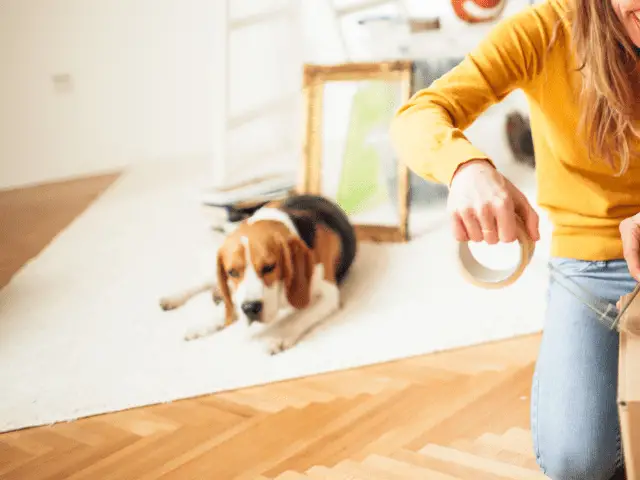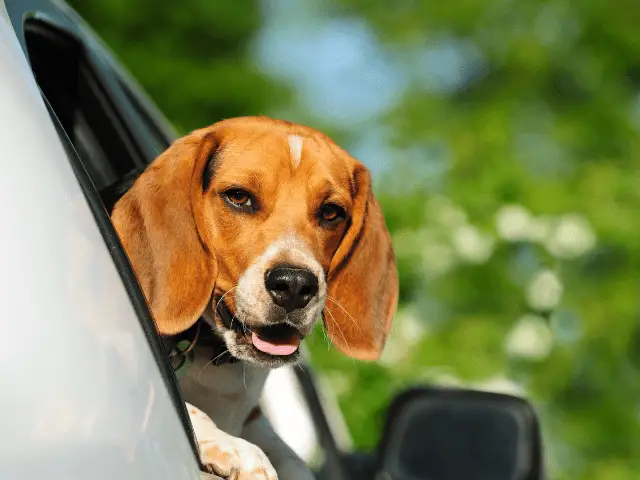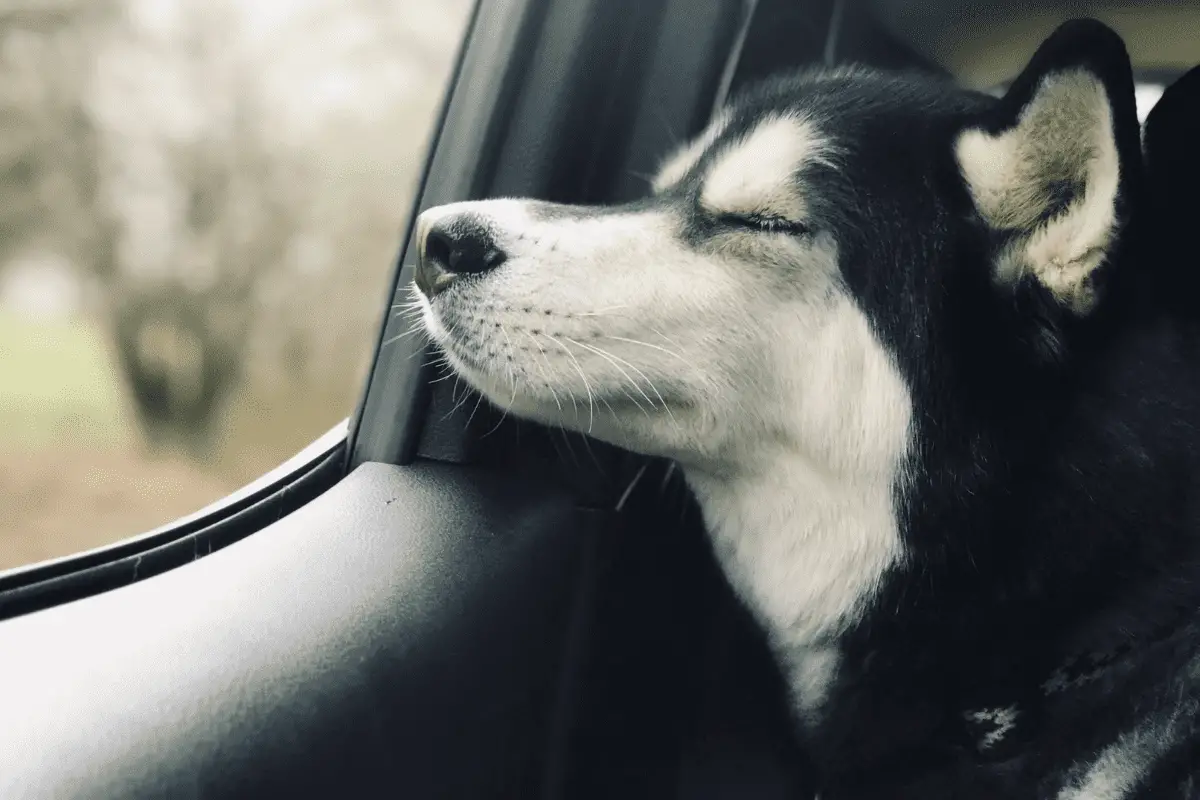Adjusting to a new home is hard on anyone, especially are furry friends. Animals thrive on consistency in their living environment and moving to a new house can be an enormous shock.
If you think of the beginnings of our domesticated buddies, they stayed in one hunting area their entire lives. The concept of significant moves is not part of their instincts. Cats are so disrupted by change that even re-arranging the furniture can be taxing.
For example, my indoor cat chewed his paw to the point of infection because he found our big cross-country move too stressful.
Your pet may feel stress at any point in the moving process. Some of the biggest stressors are packing, the actual move, and adjusting to a new house. Packing leads to stress because so many things that typically stay in place are being moved around.
Also, you may pay less attention to them as you are busy packing and preparing.
The actual move adds considerable stress to them.
Dependent on how much your dog rides in or enjoys the car may mean you are in for a rough ride. My Australian Shepherd, Ruby, loves to chase cars around the back windows of my car as they go by. She finds car rides incredibly over-stimulating. She even ate through a seat belt!
While her little brother, Pilot, lays down upon climbing in the car and is calm the whole trip.
Finally, the new house yields its own challenges. The house and yard have unfamiliar smells, the setup for going outside or where they sleep will be different, and you will still be busy unpacking.
Below I will list some tips and tricks to not only survive this move with man’s best friend, but even thrive from it. If you pay attention to your dog’s needs and remember, this is all new for them, you will come out of this with one happy pooch.
Table of Contents
Packing to Move with a Dog

As stated above, packing your home up with a dog will add stress to them. Animals thrive in stability and packing will assuredly change the layout of your home.
Nowadays, you will pack for weeks at a time in anticipation of a move. It never happens like in the movies. Movers come in and in one day your entire house goes from lived in to empty.
It is best to save your dog’s favorite items for last.
For as long as possible, leave their bed and favorite toys in their usual places. When it is absolutely time for your dog to vacate the house, pack up their belongings that they use daily and bring them with you to have out immediately at the new home.
Try your best not to change your routine. I know it is a tall order when you are in the middle of a big move, but most dogs enjoy routine and become agitated when the routine is changed.
Overall, the same number of walks, playtime, and snuggles should be on the docket. After all, this move involves your family, and your pup is part of the family too.
Moving Short Distances with a Dog
If your move is across town or within a small radius, the drive may not be too stressful on your dog. Most dogs enjoy a car ride around town. If this is the case, keep your preparation for the drive the same as you would to go to the groomer or vet.
However, if even a short drive stresses your pooch out, you made need to make other arrangements.
For example, my beagle gets car sick just by driving 3 miles to the vet. We need to plan her meals appropriately for timing, ensure she only sits in the front seat, and give her prescription medication from her vet.
A short distance move will be by car and should not need any bathroom or play breaks. Just complete your drive as quickly as possible for your dog to settle in at the new home.
Moving Long Distances with a Dog

The very first piece of advice I will give before making a long haul move with a dog is to consult your vet. Your vet my suggest ways to ease the trip for both you and your pet as well as prescribe a calming medication.
We did use medication to calm our spastic Australian Shepherd because car rides are massively taxing on her.
By Car
Personally, I have driven 1300 miles with two dogs, two cats, and two rabbits all packed into my car. A 9-week-old baby girl was in there too! Those were crazy times and let me tell you, it wasn’t easy. While I wouldn’t suggest such antics, sometimes you do not have other options.
Foremost, ensure your dog is safe for the long car ride.
You will have the car to pay attention to and do not want them to endanger you or hurt themselves. Some entertainment for your dog may also be beneficial. If they do not get carsick, you can give them a bone to chew on or their favorite toys.
You will need to take bathroom breaks. It will probably be enough for you to walk them around every time you stop to use the bathroom yourself.
While it is not advised to leave your dog unattended in a car, with this big of a move, you may need to for brief periods of time to use the bathroom and take care of yourself.
This is okay!
Keep the car running or crack some windows. Be as efficient as possible and no harm will come to your dog.
While walking your dog for their bathroom break, give them a little exercise. They will love to stretch their legs and play some tug-o-war with you.
Try to stop for mealtimes and give them plenty of time to digest. Even if your pup rarely gets car sick, they may find the stress of this move too much when eating.
By Plane
Traveling long distances by plane with a dog is a whole different game. Your vet will give you the best advice and likely provide medicine. Being on a plane is completely unnatural to a dog and an airport will add maximum stress.
Additionally, follow all the guidelines the airline lays out for traveling with a pet.
Likely, your dog will be like checked baggage. If your dog is small enough to board the plane as a passenger, you can purchase a seat for them or keep them as your personal item that is stored below your seat during flight.
However, bathroom breaks are still vital for your dog even in this mode of travel. Work with the airline to allow breaks for your dog.
Moving Into a New Home with a Dog
When you arrive at your new home, set up your dog’s area first. Fill it with all the items they are familiar with, whether it be a blanket, bed, or toy. Giving a tour of the yard and house will also allow them to familiarize themselves.
It is not uncommon for a male dog to mark to claim the property. This is perfectly okay and healthy behavior. However, you will not want them to do it in the home. Most trained dogs will not mark inside unless under severe territorial stress.
Just like with packing, routine is key. Try your best to stick to the routine your dog knows. Meals and outdoor time should stay right on schedule.
With familiar items and a routine, your dog should adjust to the new house quickly. However, observe their behaviors and if they seem to be in a permanent high level of stress, please consult with your vet.
Moving to a new home is a stressful event for everyone, including your pets. It is best to keep as much as possible the same for as long as possible. Always consult with your vet if you have any concerns about your dog and the move.
Also, if you are making a big move, make sure you know where the nearest animal hospital or your new vet’s office is located.
In the end, dogs are adaptable and will adjust to the new home. With some planning and attention, your furry friend will feel right at home in no time.

